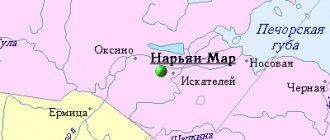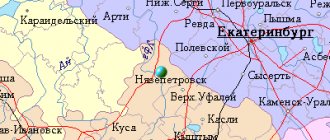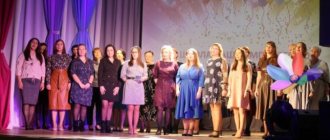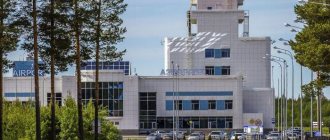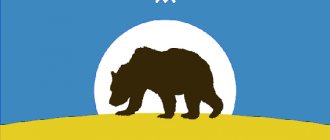KHMAO
The Khanty-Mansiysk Autonomous Okrug is truly the richest region of our country, but only after Moscow. The region is not experiencing an economic recession even now. The entire working-age population has high incomes, and local authorities are doing everything to ensure a high level of social protection for the disabled population. As a result, the number of residents is growing steadily. This happens due to natural growth and migrants.
The district administration supports residents, higher education is available to everyone, and there are many housing programs. The region is popularly called Russian Kuwait.
The residential density in the district is very low, on average there is 1 square meter per 2.7 inhabitants. km. The bulk of the population lives in cities concentrated around oil production and oil refining enterprises.
Khanty-Mansiysk
In the National Tourism Rating, the Khanty-Mansiysk Autonomous Region-Ugra does not occupy a leading position, but, nevertheless, this northern region and its capital have something to interest tourists of all ages, adults and children, regardless of the season and weather. Let's look at the most interesting things in Khanty-Mansiysk.
Cultural and tourist complex "Archeopark"
“Archaeopark” is the most popular and photographed attraction of Khanty-Mansiysk: not a single guest of the city leaves without a photo of the famous mammoths. “Archaeopark” is part of the district “Museum of Nature and Man”, the complex contains not only bronze figures of mammoths and other animals of the Ice Age, but also the Samarovsky outlier - a geological monument and the "Samarov town" - an archaeological monument.
Sculptures of mammoths in the Archeopark
© Anna Kudryavtseva
The Samarovsky outlier is a unique phenomenon in the world of science; it has been studied by geologists from around the world for more than a hundred years, and to this day there is debate about its origin. At the top of the hill is the town of Samara, which, according to legend, was the residence of the Ostyak prince Samara in the 16th century. The figures of mammoths did not appear here simply: numerous archaeological finds made in the floodplain of the Irtysh River confirm that mammoths once roamed here near the sites of primitive man.
Mammoths were installed at the Samarovsky outcrop in 2007; there are eleven figures in the composition, the smallest being a 3-meter-high mammoth calf. In addition to them, here you can see cave bears, a cave lion, a pack of wolves, a pair of woolly rhinoceroses, primitive bison, a herd of horses and beavers, and a family of primitive people. The author of the sculptures is People's Artist of Russia Andrey Kovalchuk.
Ethnographic open-air museum “Torum Maa”
“Torum Maa” is translated from the Mansi language as “Sacred Land”. This museum is located on one of the forested hills of the capital of Ugra. The museum was founded in 1987 by representatives of the national intelligentsia from among the Khanty and Mansi. Among them are Eremey Danilovich Aipin, a Khanty writer, and Yuvan Nikolaevich Shestalov, a Mansi poet.
Ethnographic Museum "Torum Maa"
© Anna Kudryavtseva
The Khanty and Mansi belong to the Finno-Ugric language family and are united under a common name - Ob Ugrians. In the open areas of the museum, a reliable reconstruction of the life of the Ob Ugrians was made.
The Ob Ugrians led a semi-nomadic lifestyle. In winter they lived in permanent winter settlements with permanent buildings, and in the spring they went to seasonal settlements on fishing grounds, depending on their occupation. The traditional occupations of the Ob Ugrians are river fishing, taiga hunting, reindeer herding, and gathering.
In the museum you can see the “Summer camp of the Khanty of the Agan River” and the “Winter settlement of the Eastern Mansi”, look into tents and houses, learn how bread was baked in an adobe bread oven, how food was stored and many details of the life of the indigenous peoples of the North.
You can visit the active sanctuary of the Ob Ugrians, as well as walk along a hunting trail, see how traps for large and small animals are made, and learn the principle of their operation.
Orthodox complex “In the name of the Resurrection of Christ”
The Orthodox complex “In the Name of the Resurrection of Christ” is located on one of the seven hills in the central part of the city; it was built in honor of the 2000th anniversary of the Nativity of Christ. The complex includes:
- Temple complex "In the name of the Resurrection of Christ"
© Anna Kudryavtseva
Cathedral of the Resurrection of Christ;
- bell tower 62 meters high;
- chapel in the name of Saints Equal-to-the-Apostles Cyril and Methodius;
- Orthodox gymnasium with a single-domed baptismal church in honor of the Holy Equal-to-the-Apostles Prince Vladimir.
Next to the complex is the Orthodox Park, and in front of the cathedral is the Square of Slavic Literature and Culture, in the center of which is the cascading fountain “Road to the Temple,” dedicated to the Ten Biblical Commandments. On the territory there are also monuments to Saints Cyril and Methodius, the educators of the Slavs, as well as Metropolitans Philotheus Leshchinsky and John of Tobolsk.
Park named after Boris Losev
The park named after Boris Losev is located in the central part of the city and is very popular among local residents. It is named after a Komsomol member who died during the Civil War at the hands of the White Guards; a monument to him once stood on the site of the park. The central entrance to the park is located opposite the Ugra-Classic concert hall; there are arches of twelve columns, decorated with colored mosaics and illuminated in the evening.
Rotunda in the park named after. Boris Losev
© Anna Kudryavtseva
This wonderful birch park is man-made; it was planted in the 1930s by the grandfathers and great-grandfathers of today’s city residents. In the summer this is an escape from the heat, and it also happens in the north. On hot days the park is crowded at any time of the day.
The main decoration of the park is a cascade of fountains, where the main one is the unusual “Ob and Irtysh” fountain. In the center of the fountain is a mountain made of six different types of granite, around which sculptures of representatives of the animal world of Ugra are placed: moose, bears, deer, wild boar, wolves, as well as Siberian Cranes - white cranes - endemic to the northern regions of our country. On the back side of the fountain, an eagle owl holds a scroll with the inscription: “Where the gray-haired Irtysh meets the Ob, behind the centuries-old mountain the city rises.”
The park has a small artificial lake with a rotunda, as well as bridges across it, which are decorated with figurines of angels. In the park you can meet not only angels; there is a fairy on the shore of the lake. As the authors of the idea write: “The girl is a kind fairy fairy who personifies joy and happiness. The image of a star, which the fairy holds in her hand, depicts a dream - achievable and very real.”
"Baby Mammoth"
© Anna Kudryavtseva
According to the legend, which, of course, soon appeared, if you throw a coin into a magic shoe and make a wish, the good sorceress will definitely fulfill it. The author of the monument is Kurgan sculptor Lyudmila Laperdina. She also created a funny baby mammoth. By the way, “Baby Mammoth” was created on the basis of children’s sketches of the future monument, for which a competition was announced, and the most popular was the image of a baby mammoth from the famous cartoon “Mother for a Baby Mammoth.”
A significant part of the park is occupied by a children's playground, where there is a lot of all sorts of entertainment for children, and there are comfortable benches for parents.
More information in the section Parks of Khanty-Mansiysk
Winter Sports Center named after. Alexandra Filipenko
Winter Sports Center named after. A. V. Filipenko is an international stadium where competitions in various types of biathlon and cross-country skiing are held.
Winter Sports Center named after. A.V. Filipenko
© Anna Kudryavtseva
Its history began in the 1960s, but it acquired its modern appearance after reconstructions in the late 1990s and 2009. The biathlon center is a stadium that can accommodate up to 15 thousand spectators, 15 kilometers of tracks in the picturesque Siberian nature, a shooting range for 30 electronic and mechanical targets, and a children's sports school.
The Biathlon World Championships were held here in 2003 and 2011, and the final stages of the Biathlon World Cup were also held more than once.
The KhMAO-Yugra national teams in biathlon, snowboarding, archery, biathlon, skiing, and athletics train at the Winter Sports Center.
Concert and theater
The concert and theater was solemnly opened in 2004 on the Day of the formation of the Khanty-Mansiysk Autonomous Okrug. His project was developed by a group of Moscow architects under the leadership of Svetlana Peid, he received a gold diploma from the Zodchestvo festival in Moscow and a silver medal in Bulgaria at an international competition of architects.
CTC "Ugra-Classic" is a multifunctional complex with four auditoriums, a conference hall "Amadeus", an art salon, a club-restaurant "Vienna Cafe", a hotel with 30 rooms.
CTC "Ugra-Classic"
© Anna Kudryavtseva
The Great Hall is a multifunctional hall with 1,000 seats with the most modern lighting and sound equipment; its acoustics meet the highest world standards. The heads of leading Russian theaters and foreign theaters that toured in Khanty-Mansiysk consider the stage of the Ugra-Classic Cultural Center to be the best touring venue in Russia in terms of technical and organizational parameters.
The organ hall seats 200 spectators, and chamber concerts are held here. It contains a unique wind organ made by the famous German, its keyboard is trimmed with mammoth bone. Dozens of outstanding performers from around the world performed here.
The press room is intended for press conferences, meetings with journalists, briefings, and is equipped with a simultaneous translation system. The Transformer studio hall has only 80 seats; it is used for talk shows, club meetings, rehearsals, exhibitions, children's matinees, and jazz concerts.
At the Ugra-Classic CTC, residents of the Ugra region have the opportunity to meet the best Russian and world-class performers.
Church of the Intercession of the Blessed Virgin Mary
The Church of the Intercession of the Blessed Virgin Mary is located in Samarovo, the historical district from which the city of Khanty-Mansiysk began.
Church of the Intercession of the Blessed Virgin Mary
© Anna Kudryavtseva
The temple in the Siberian Baroque style was built according to the design of the architect Shangin to replace the wooden church of St. Nicholas the Wonderworker that stood on this site and was consecrated in 1816. Under Soviet rule, the church was looted and dismantled, the bricks were used to build a fish factory, and a club was built on the site of the church.
The existing Church of the Intercession of the Blessed Virgin Mary was built on the foundation of a historical temple and in its previous form, was consecrated in 2004. The church has three altars; in addition to the main altar, there are two chapels - in honor of the Abalak Icon of the Mother of God and in honor of St. Nicholas the Wonderworker.
Road bridge over the Irtysh "Red Dragon"
The road bridge across the Irtysh , which was called the “Red Dragon” for its shape and red color of the structures, was opened in 2004.
"Red Dragon"
© Anna Kudryavtseva
This is the pride and one of the calling cards of Khanty-Mansiysk; it is not for nothing that in 2013 it took second place in the online voting “The most beautiful bridge in Russia”, losing only to the Murom cable-stayed bridge across the Oka. Thanks to this bridge, the northerners have a shorter route to the central regions of the European part of the country: from Nizhnevartovsk, Surgut, Strezhevoy and other cities, the route through this bridge leads to Serov, Perm, Kirov and further to Moscow. The total length of the bridge is 1361 meters.
Fountains
There are many beautiful fountains in Khanty-Mansiysk, which you would never expect to see in a city located in harsh climatic conditions. These are the “Rotunda” fountain on the Central Square, the cascading fountain “Ten Commandments” on the way to the Cathedral of the Resurrection of Christ, the fountains of the park named after. Boris Losev.
But the most original fountain, the “Faberge Egg” in the shape of a precious egg by jeweler Carl Faberge, was installed in 2008 on the square in front of the building of the Arts Center for Gifted Children of the North. It is a symbol of creativity, which underlies all types of art. The egg is surrounded by an openwork bronze bowl standing on a granite base.
Fountain "Faberge Egg"
© Anna Kudryavtseva
This fountain is a tribute to the great jeweler; in 2007, an exhibition of works by Carl Faberge was held in Khanty-Mansiysk, where nine Easter eggs were shown, including a coronation egg commissioned by the Imperial House of Romanov.
On a fine day, the fountain shimmers in the sun, thanks to the interspersed pieces of smalt, but it is especially beautiful in the evening, when the unusual colored lighting is turned on.
Museums
When visiting Khanty-Mansiysk, you should definitely include a visit to museums in your program; the museums of the capital of Ugra will not disappoint even tourists who have seen a lot.
Skeleton of a trogontherian elephant
© Anna Kudryavtseva
The Museum of Nature and Man is the oldest museum in the district; it was first opened to visitors in 1936. The museum collection contains about one and a half thousand monuments of the culture and history of Ugra, many of which are unique.
Here you can learn about the amazing nature of Ugra, the way of life, customs, folklore of the indigenous peoples of the North, and get acquainted with the flora and fauna of the region. The halls display unique exhibits, including the skeleton of a trogontherian elephant - the direct ancestor of the woolly mammoth, of which there are only a few such in the world.
The State Art Museum of Khanty-Mansiysk is a unique museum collection, one of the youngest in the country. His collection includes specimens of a national scale: icons of the 15th–16th centuries, paintings by famous Russian artists - I. I. Levitan, V. I. Surikov, I. K. Aivazovsky, I. E. Repin, F. S. Rokotov and others .
House-Museum of People's Artist of the USSR V.I. Igosheva
© Anna Kudryavtseva
The Art Museum includes: House-Museum of People's Artist of the USSR V. A. Igoshev and Gallery-Workshop of artist G. S. Raishev.
The House-Museum of People's Artist of the USSR V. A. Igoshev occupies a building that is often called a “gingerbread house.” The museum is dedicated to the work of Vladimir Ivanovich Igoshev, whose paintings reflected the beauty of the Siberian land, its history and culture, the originality of the characters of the people inhabiting Ugra. The museum's exhibition features more than a hundred works by the artist from his Northern Cycle; you can also see the artist's study and workshop.
And this is not all that the capital of Ugra can offer to lazy and inquisitive tourists. Khanty-Mansiysk has unusual buildings, such as the building of the Ugra Chess Academy , designed by the famous Dutch architect Erich Van Egeraat. We recommend visiting it in the evening when its color-changing lights are turned on.
Monument to Ugra residents who died in local wars
© Anna Kudryavtseva
The city has many beautiful monuments dedicated to historical events or people who left a mark on the history of Ugra: monuments to the “Founders of the City of Khanty-Mansiysk” , “Great Siberian Expeditions” , “Bronze Symbol of Ugra” , “Discoverers of the Ugra Land”, a monument to Farman Salmanov - the discoverer Tyumen oil, a monument to Kh. M. Loparev, a local historian who wrote a book about the history of his native village of Samarovo, and many others. In different areas of the city you can also find many interesting urban sculptures.
More interesting things in the section Sights of Khanty-Mansiysk
Composition of the district
According to statistical data for 2021, the list of cities in Khanty-Mansi Autonomous Okrug consists of 16 territorial units. There are only 2 large cities in the district; this “pair” does not even include the center of the administrative unit of Russia - Khanty-Mansiysk.
1. The city of Surgut with a population of 360 thousand people. The history of the settlement begins in 1594. The city is an important transport hub for the entire district, located on the banks of the Ob River.
2. The city of Nizhnevartovsk with a population of 274 thousand people. The settlement was founded in 1909, and city status was granted in 1972. The city is located on the banks of the Ob River and is one of the main oil production and processing centers of the entire country.
Nefteyugansk
The list of cities in Khanty-Mansi Autonomous Okrug with a large population ends at the two described above. The list of cities with a population of 100 to 250 thousand people includes only one territorial unit - Nefteyugansk. According to 2021 data, a little more than 126 thousand people live here.
The city is practically saturated with black gold. There is a running joke here that the entire history of the city is written not in blood, but in oil. Previously, only geologists lived in the settlement. And as soon as oil flowed out of one of the wells almost like a fountain in 1962, the village gradually began to transform into a city that is known throughout the Russian Federation. The average age of people living here is 33 years, that is, the settlement is completely young.
Area and information
Khanty-Mansi Autonomous Okrug is one of the constituent entities of the Russian Federation, which is territorially included in the Tyumen region. In terms of economic indicators, it is a donor region due to its developed oil and gas industry. The area of the Autonomous Okrug is 534,801 km².
In the Autonomous Okrug, by 2021, there are 16 cities, the number of which varies from 18,076 (Pokachi) to an urban agglomeration with a maximum number of residents of 380,000 in the city of Surgut.
Also, 24 urban-type settlements remain inhabited in the territory. However, it is worth noting that in the period from the 50s to the 80s there were more of them. At least 6 units. But the overwhelming number of them, over time and the development of industry, grew and transformed into cities, such as Nefteyugansk, Beloyarsk, Surgut and some others.
They were at first small settlements, but thanks to the fact that the industry associated with the extraction of minerals was productively established, they grew into fairly large cities with well-developed infrastructure.
Medium-sized cities
Next, the list of cities in Khanty-Mansi Autonomous Okrug can be presented alphabetically as follows.
| City name | Population, people (2017) |
| Khanty-Mansiysk, capital | 98 692 |
| Kogalym | 64 846 |
| Nyagan | 57 765 |
| Megion | 48 283 |
| Langepas | 43 534 |
| Rainbow | 43 157 |
| Pyt-Yakh | 40 798 |
| Urai | 40 559 |
| Lyantor | 39 841 |
| Yugorsk | 37 150 |
| Soviet | 29 456 |
| Beloyarsky | 20 142 |
The final city on the list is Pokachi. However, it cannot be considered even medium-sized, since only 18 thousand people live in it as of 2015.
Kogalym
Despite the sharply continental climate with harsh and long winters, the city's population is steadily growing. In 2021, just over 63 thousand lived here, and in 2017 there were already 1,370 more people. Near the city there is a settlement called Ortyagun, subordinate to Kogalym, only 142 people live in it, who mainly serve the railway bypass.
Lyantor
The list of cities and towns in the Khanty-Mansi Autonomous Okrug includes the city of Lyantor, which occupies one of the lowest places in the district’s ranking. It belongs to the Surgut region. The settlement is located on the Pima River, a tributary of the Ob. The region is classified as the Far North. The climatic conditions here are quite difficult, the average temperature in January is 22 degrees. Snow cover persists from October to May. As of 2021, the city has a population of 39,800. Since 2016, there has been a decline in numbers; in 2015, there were 40,135 people.
Beloyarsky district
The district was formed back in 1988; today (2017) it is home to 29,390 people. The population density in the area is very low, approximately 0.7 people per 1 sq. km. The territorial unit consists of 1 city - Beloyarsky, and 6 rural settlements.
The villages have an average of 1,400 people. These are Polnovat, Kazym, Sosnovka, Verkhnekazymsky, Lykhma and Sorum.
Gender and age
Considering the distribution by gender in the region, it is worth noting that the number of women here, since 2005, has always prevailed over the number of men. Here are the indicators Rosstat shows, indicating the number of women per 1,000 men:
- In 2005, the fairer sex numbered 1,026.
- In 2010 – 1041.
- By 2014 – already 1052.
- By 2021 – 1053 women.
- And by 2021, there were 1,054 women per 1,000 men.
As can be seen, under the influence of a number of factors, including the shorter life expectancy of men, the number of women per 1000 males is constantly growing. If we consider age indicators, then today the age composition of the population is divided as follows by the end of 2021:
- Children under 1 year – 22,500.
- Children under 7 years old – 186,000.
- From 8 to 13 years – 136,000.
- From 14 to 17 years old – 80100.
- From 18 to 19 – 31.000.
- From 20 to 24 – 83.600.
- From 25 to 29 – 110.200.
- From 30 to 34 – 161.500.
- From 35 to 39 – 154.600.
- From 40 to 44 – 136,300 people.
- From 45 to 49 – 119.500.
- From 50 to 54 years old – 109,500.
- From 55 to 59 years old – 127,200.
- In the age group 60-64 years – 95,500.
- In the range from 65 to 69 years – 58,000.
- Over 70 – a little over 52,000.
Thus, the working population is a total of 1003,700 citizens, the younger than working population is 386,600. But the pension category of people is 273,500.
Leaders in population growth
To this day, the cities of Khanty-Mansi Autonomous Okrug and Yamal-Nenets Autonomous Okrug are recognized as leaders in population growth. It’s sad, but if we take statistics throughout Russia, the population is slowly but surely dying out. Completely different trends are observed in these two regions.
The leader on the list is the city of Khanty-Mansiysk. If we compare the present time with 1989, the population growth has been more than 170%. Most of the residents in the city appeared in the 2000s, when there was an opportunity not only to survive, but even to earn very good money.
In general, the Yamal-Nenets Autonomous Okrug (+23%) and Khanty-Mansi Autonomous Okrug (+22%) in terms of population growth over the past 25 years could not overtake only Dagestan and Ingushetia.
Migration
If we consider migration issues, here is what the inflow and outflow of the population looks like year by year over the past few years:
- 76217 people arrived in 2021.
- In 2021, this figure was 75,582.
- The bulk of arrivals are Russians who migrate within the country. Their number accordingly amounted to about 66,000 over 2 years.
- Of international migration, most citizens came from Azerbaijan, Armenia, and Tajikistan. Less so from other Slavic republics of the former USSR.
- But the picture will be incomplete if we do not say that there is a category of people who leave Khanty-Mansi Autonomous Okrug. So, for the same reporting period from 17 to 18. XXI century, the number of those leaving was about 80,000 annually. Moreover, the main part moves within the country, settling in other regions.
This is what the demographic situation looks like in the Khanty-Mansiysk Autonomous Okrug. And now it has a positive character compared to many other regions of the country.


